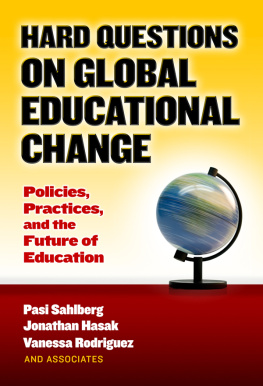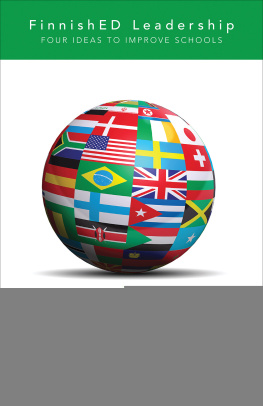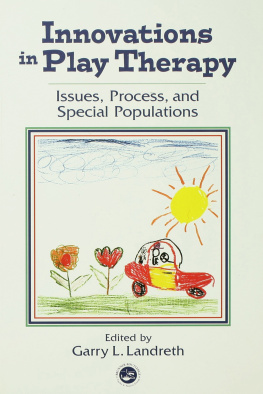Let the Children Play

Oxford University Press is a department of the University of Oxford. It furthers the Universitys objective of excellence in research, scholarship, and education by publishing worldwide. Oxford is a registered trade mark of Oxford University Press in the UK and certain other countries.
Published in the United States of America by Oxford University Press
198 Madison Avenue, New York, NY 10016, United States of America.
Pasi Sahlberg and William Doyle 2019
All rights reserved. No part of this publication may be reproduced, stored in a retrieval system, or transmitted, in any form or by any means, without the prior permission in writing of Oxford University Press, or as expressly permitted by law, by license, or under terms agreed with the appropriate reproduction rights organization. Inquiries concerning reproduction outside the scope of the above should be sent to the Rights Department, Oxford University Press, at the address above.
You must not circulate this work in any other form and you must impose this same condition on any acquirer.
Library of Congress Cataloging-in-Publication Data
Names: Sahlberg, Pasi, author; Doyle, William, author.
Title: Let the children play : how more play will save our schools and help
children thrive / Pasi Sahlberg, William Doyle.
Description: New York : Oxford University Press, 2019.
Identifiers: LCCN 2018045120 | ISBN 9780190930967 (hardback) | ISBN 9780190932169 (epub)
Subjects: LCSH: PlayPsychological aspects. | Play schools. |
Child psychology. | Child development. | BISAC: EDUCATION / General. |
EDUCATION / Educational Psychology. | EDUCATION / Preschool & Kindergarten.
Classification: LCC BF717.S324 2019 | DDC 155.4dc23
LC record available at https://lccn.loc.gov/2018045120
This book is dedicated to our families:
Otto, Noah, Eero, Brendan, Petra, and Naomi.
The lifelong success of children is based on their ability to be creative and to apply the lessons learned from playing.
It could be argued that active play is so central to child development that it should be included in the very definition of childhood. Play offers more than cherished memories of growing up, it allows children to develop creativity and imagination while developing physical, cognitive, and emotional strengths.
American Academy of Pediatrics Clinical Report
Children discover the world through play and reveal their creative abilities. Without play, full intellectual development is impossible. Play is a huge open window through which a life-giving stream of concepts and ideas pours into the childs spiritual world. Play is a spark, igniting the fires of inquisitiveness and curiosity.
Vasily Sukhomlinsky, Founder, School of Joy
The playground at Maple Street Elementary School is quiet these days.
The only movements on the swing sets are a result of a strong west wind edging the swings back and forth. The long lines that once formed for trips down the sliding boards are empty. There are no softball or kickball games nor are there any games of tag or duck-duck-goose being played. There wont be a fifth-grade musical this year.
Children will not be learning to play the recorder nor will they be learning to march to rhythms or learn the traditional songs that have transcended the years of music instruction in elementary schools. There will be no art to display. Daddies old long sleeved shirts that were handed down to children to cover up school clothes to keep from being stained with tempera paint and water colors are no longer needed.
No, Maple Street Elementary School is not closing. It is squeezing every minute of the school day to meet the mandates of the No Child Left Behind Act (NCLB) and in so doing many parents and educators
Joan Henley, Jackie McBride, Julie Milligan, and Joe Nichols
They ran among the trees, they slipped and fell, they pushed each other, they played hide-and-seek and tag, but most of all they squinted at the sun until the tears ran down their faces; they put their hands up to that yellowness and that amazing blueness and they breathed of the fresh, fresh air and listened and listened to the silence which suspended them in a blessed sea of no sound and no motion. They looked at everything and savored everything. Then, wildly, like animals escaped from their caves, they ran and ran in shouting circles. They ran for an hour and did not stop running.
Ray Bradbury, All Summer in a Day
Contents
When you were a child, how much time did you spend playing outdoors? By playing, I mean making up games on your own or with friends, running around and falling over, all for the sheer fun of it. I expect it was many hours every week. Im a baby boomer and when I was growing up in inner city Liverpool, my siblings and I took every opportunity to get out of the house and play. Like cats, we only went home for the food. We played in the streets, in the back alleyways and in the local park, with each other and with other kids from the neighborhood.
We played running and chasing games, hiding games, ball games; and improvised adventure games, often based on stories wed read in comics or seen at the Saturday cinema matines. Our parents did much the same when they were children and so did their parents. From time immemorial, children have spent countless hours outdoors immersed in physical, imaginative, social play. Not any more. Children now spend much less time playing like this than ever before, and the consequences are incalculable.
Let the Children Play argues vividly that play is vitally important in young lives. Childs play may be highly enjoyable but it is not trivial. To grow and thrive, children have to play. Active, physical play is a primary way that children learn about themselves and the world around them. It is essential to the healthy development of their minds and bodies and to cultivating the complex personal and social skills they need to make their way in the world. Active play should be a regular part of every childs daily life. As this book also shows, for many children the reality is depressingly different. For a variety of reasons, and in many parts of world, children from the earliest ages are being systematically deprived of their need, and their right, to play.
I know this from my own experiences in education and more broadly. I am currently senior advisor and chair of Dirt is Good (DiG), an international initiative funded by Unilever to promote better provision for childrens play. The campaign emerged from a growing concern that childrens lives are now increasingly out of balance and that active, physical play is being squeezed out by other demands and constraints. In 2015, the campaign commissioned an international survey of parental attitudes to play. The survey included over 12,000 families in 10 countries: Brazil, China, India, Indonesia, Portugal, South Africa, Turkey, the UK, the United States, and Vietnam. It confirmed that children everywhere spend much less time than previous generations on self-directed outdoor play.
Almost two-thirds of parents say their children have fewer opportunities to play outside than they did themselves as children. Over half of children spend less, often much less, than 1 hour a day on outside play. Play is increasingly an indoor rather than an outdoor experience. Almost 1 in 10 children never play outside at all. By the way, the accepted convention for the treatment of high-security prisoners is that they spend at least 1 hour a day relaxing and exercising outdoors. Evidently, many children around the world are now spending more time indoors than convicted criminals. This does not mean that children are not playing at all, but they are playing differently. As youll see in the chapters that follow, these days, when children play outside, they are often supervised by adults in organized games and activities. When they play indoors they spend most of their time on screen-based games. Whats wrong with that and what sorts of play matter most?










